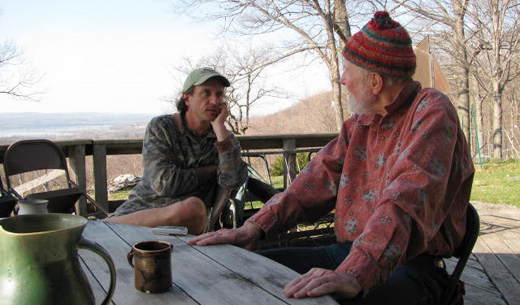
Part 1 of a 3-part story
Today is Pete Seeger’s 92nd birthday. Happy birthday Pete!
David Kupfer visited with Pete Seeger just before his 90th birthday in the spring of 2009, on a warm afternoon. The home he shares with his wife Toshi overlooks the Hudson River and Denny’s Point near Beacon, New York. This is the first installment of a three part series based on the interviews.
Pete Seeger’s main profession has been as a student of American folklore, and he has made a living as a banjo picker for close to 70 years. As well, Seeger has been one of the nation’s quintessential activists, having played an important role in singing the songs and engaging in the civil rights, free speech, anti- war, environmental, peace, and social justice struggles and movements of his time.
He spans musical eras, from those who provided inspiration to him, such as Woody Guthrie and Leadbelly, to those he has inspired – Joan Baez, Bob Dylan, Martin Luther King, Bruce Springsteen, Ani DiFranco, Dave Mathews, and countless others.
Pete is an excellent historian and a wonderful storyteller.
The power of the song
David Kupfer: What is it about the power of a sing along song?
Pete Seeger: There is something about participating; it is almost my religion. If the world is still here in 100 years, people will know the importance of participating, not just being spectators. That’s what this book, “Blessed Unrest,” by Paul Hawken, is about. Millions of small groups around the world, that don’t necessarily all agree with one another, are made up of people who are not just sitting back waiting for someone to do things for them. No one can prove anything, but of course if I didn’t believe it had some kind of power, I wouldn’t be trying to do it.
Herbert Hoover said to Rudy Vallee, who was a top singer in 1929, “Mr. Vallee, if you can sing a song that will make the American people forget the depression, I will give you a medal.” A lot of musicians would like to get that kind of medal. Bing Crosby had a hit record: “Wrap your troubles in dreams, and dream your troubles away.” That was how we were going to solve the depression in 1932.
DK: I never thought of those singers as propagandists.
PS: The exception proves the rule. A lefty named Yip Harburg got a musician named Jay Gorny to write a tune for him and wrote: “Brother can you spare a dime.” Yip got together in 1938 with Harold Arlen to make songs for the movie version of The Wizard of Oz. He said “Harold, get me a melody for the phrase ‘over the rainbow.’ ” Arlen said, “there’s no rainbow in the Wizard of Oz, I’ve read the script.” “I’m putting it in,” said Yip. When they got this great melody, the producer tried to cut it from the movie. The two songwriters said, “this movie will not be made unless this song is in it”. They went on a two-man strike. They had hundreds of thousands of dollars going out every day, extras, scenery, cameramen. Finally Louis B. Mayer said, “oh, let the boys have their way, let’s get rolling.” So they won the strike.
Music for social change
DK: Do you think protest music has changed since the 60s?
PS: I don’t know enough because I don’t listen to records, but my guess is that there are many, many different kinds now, some slow and serious; some are loud and shouting; satirical. Somebody I just met recently wrote a very good poem and was looking for a tune for it. He wanted me to help and I said, “don’t count on me…go find it.” He wanted to know if I would make a tune up for him. I pointed out a couple of ways it could be better – to repeat the lines and have more repetition. Think of the great songs that are just full of repetition.
DK: What is the most pronounced thing that you have seen that a song has been able to accomplish?
PS: The civil rights movement. Songs did a lot for unions, but the civil rights movement would not have succeeded if it hadn’t been for all those songs. They were sung in jails and on picket lines and parades. People hummed them when they were most beaten.
DK: Folk music has proven to be a useful tool in many social change movements that have succeeded in the past 60 years. Does it make you optimistic about the potential for social change?
PS: I am more optimistic today than I’ve ever been in my life. When I was 16, I argued with some other teenagers from a Jewish family. They asked, “what are you going to do with your life?” I said, “I’m going to be a hermit. This world is so full of hypocrisy, the only way you can be honest is to be a hermit. I don’t know how I’m going to make a living but I’m going to try. I thought I might be a forest ranger or something like that. Being out in the woods was my church.
Examining folk culture
DK: How do you think folk music serves to influence and mold a culture?
PS: I think it helps reinforce your sense of history. An old song makes you think of times gone by. Then, the idea that you can make up songs has taken over and I look upon us all as Woody’s children. There’s a man in the Bronx, Robert Sherman at radio station WFUD and he’s got a weekly program called Woody’s children. I gave him the phrase and he plays new songs written by famous and unknown people.
DK: What do you think has been lost with the advent of all this commercially recorded music that has altered the folk culture?
PS: The danger with the internet is that you don’t need to think about it, you just search for it and you find the answer. Singing used to be part of everyday life. Women sang while pounding corn. Men sang while paddling canoes.
DK: How have you seen the content of popular commercial change?
PS: During the 1930s, the Establishment had music quite under its control. Hit songs came out of Broadway or Hollywood. A few people down South listened to what they called the Hillbilly and the Race catalogues of the record companies. And the Race catalogues were either gospel or the blues. Bluegrass didn’t come in until the 1950’s. Bluegrass, Rock and Roll, and Motown all came in, and the songs that everybody listens to have really been out of control since then. Up until then they were pretty much under control by the Establishment, including the songs that the kids learned in school.
Making music
DK: It seems like a lot of folk songs have really simple chord structures. Why is it some of the simplest songs are the most moving and evocative?
PS: Some very simple melodies have never been forgotten through history. The tune used for “Twinkle, Twinkle, Little Star” is known in every country in Europe in many different forms (sings five verses in five languages). Who knows? It could have been somebody in a cave dancing around – “bud dom bud dom bud dom bud dom.” Maybe they are just easy to remember, so simple yet so memorable.
DK: How do you balance your inspiration to write new songs with your quest to sing and nurture old traditional folk songs?
PS: Sometimes you find an old tune so good you can use it several times for different purposes. Richard Farina used an old English melody that I used for a song against the Vietnam War. (Proceeds to hum a melody.)
DK: Was there some ‘aha moment’ when you realized that singing folk songs was to be your life’s work, feeding the flame of folk music spirit?
PS: Originally, I didn’t realize what was going to happen. Most people would ask me, “don’t you want to make a hit record?” But I really didn’t like the hypocrisy of the music business. It was almost an accident when a song I wrote became a hit. I did happen to meet Bob Miller, who’d come up from Memphis, Tenn., in New York. He’d written a song, which was widely popular in the South around 1922.
(sings)
Seven cent cotton and forty cent meat,
How in the world can a poor man eat?
Flour up high and cotton down low,
How in the world can we raise the dough?
Clothes worn out, shoes run down,
Old slouch hat with a hole in the crown,
Back nearly broken and fingers all sore,
Cotton gone down, to rise no more.
– To be continued –
David Kupfer is a freelance feature article contributor on topics related to the environment and agriculture for a variety of publications. He produced the San Francisco Green Map and is an educator, lecturer and consultant on environmental issues.
Photo: David Kupfer and Pete Seeger at the Seeger home overlooking the Hudson River.
To read more about the life and work of Pete Seeger, check out these articles from our archive
Sign Pete Seeger’s birthday card here .
Pete Seeger on youth, careers, and social movements,
Pete Seeger on Woody Guthrie, youth and the environment,












Comments